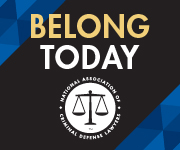Following community outcry regarding instances of police misconduct and violence, many communities call for the deployment of body cameras as a means to monitor and document events. As more and more law enforcement agencies have added body cameras, the use of these devices has come under increasing scrunity on a number of fronts. Issues range from those surrounding practical issues such as when the cameras are (and are not) engaged, how long footage is retained, and how the information is transmitted; their impact on prosecutor and defender workload; evidentiary issues arising from narration and viewpoint bais; questions surrounding public access to footage; and the use of cameras to engage in mass survelliance.
Defenders must know and understand the policies and practices surrounding body camera implementation, as well as the evidentiary and legal challenges that arise in the admission and presentation of camera footage. To aid defenders, NACDL has created a number of resources.
Learn more about NACDL's work on Body Cameras by visiting
NACDL's Fourth Amendment Center
Additional Materials
General Information:
Body Worn Cameras and the Courts, National Center for State Courts (2016)
Body Worn Camera Laws Database, National Conference of State Legislatures:
Considering Police Body Cameras, 128 Harv. L. Rev. 1794 (2015)
Justice Visualized, Mary D. Fan, 50 U.C. Davis L. Rev. 2017
Police Body Worn Cameras, Seth Stoughton, 96 N.C. L. Rev. 1363 (2018)
Policing Body Worn Cameras: A Policy Scorecard, Upturn (2017)
Problems with Juror Bias in Viewing Body-Camera Video Evidence, Excited Utterance: Evidence and Proof podcast, Episode #72, (July 2019)
Video Evidence a Primer for Prosecutors,BJA:(2016)
Evidentiary Issues:
Machine Testimony, A. Roth, 126 Yale L. J. 1972 (2018)
Missing Police Body Camera Videos: Remedies, Evidentiary Fairness, and Automatic Activation, Mary Fan, 52 U. Ga. L. Rev. 57
No Tape, No Testimony: How Courts Can Ensure Responsible Use of Body Cameras, ACLU of Mass., UC Berkeley School of Law (2016)
Policing the Admissibility of Body Camera Evidence, Bellin and Pemberton, 87 Fordham L. Rev. 1429 (2019)
When Discretion to Record Becomes Assertive: Body Camera Footage as Hearsay, Note, 20 Vand. J. Ent. & Tech. L. 4, 1259 (2018)
Camera Perspective and Playback Speed:
Body Camera Obscura: The Semiotics of Police Video, C. Morrison, 45 Am. Crim. L. Rev. 791 (2017)
Cross-Examining Film, J. Silbey, 8 U.MD L. J. Race, Religion, Gender & Class 17, (2008)
Hidden Biases of Cameras, Slate, Aug. 2015
How Body Cameras Distort Real Life, New York Times, Opinion, August 8, 2019
Police Body Cameras: What Do You See? New York Times, April 4, 2016
The Camera Perspective Bias: A Case Study, 4 J. Investigative Psychol. & Offender Profiling, 199 (2007)
The Illusion of Accuracy: How Body-Worn Camera Footage Can Distort Evidence, Upturn (2017)
Slow Motion Increases Perceived Intent, E. Caruso, Proceedings of the National Academy of Sciences (2016); see also YouTube Video of same title
Truth, Lies, and Meaning in Slow Motion Images, S. Rogers, Psychocinematics, (2013)














